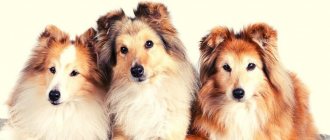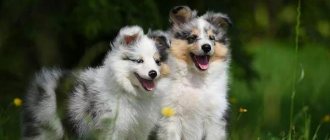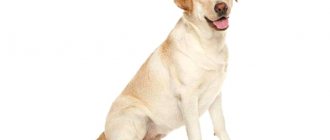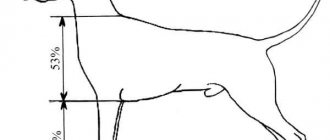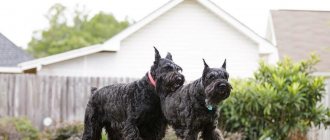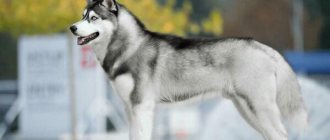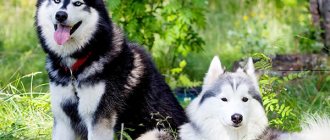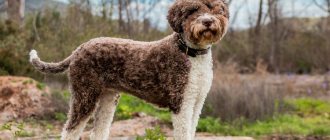The Sheltie is one of the smallest cattle dogs bred in the UK. It appears to be a miniature version of a long-haired collie. But these are two separate breeds, although the difference between them is not immediately noticeable. The Sheltie's popularity is explained by its compact size, high intelligence, beautiful appearance and amazing character. But you shouldn’t get such a pet without first studying its description, pros and cons, and reviews.
- Head
- Features of education and training
- Sheltie coat care
Breed traits
Breed traits (on a 5-point scale)
| Sheltie (Shetland Sheepdog) | |||
| Activity | in the house | 3.1 | |
| on the street | 3.8 | ||
| Obedience | training | 4.7 | |
| strangers | 4.6 | ||
| Domination | in family | 1.5 | |
| over dogs | 2.1 | ||
| Defending your territory | from people | 2.1 | |
| from dogs | 2.5 | ||
| Sociability | in family | 4.7 | |
| with strangers | 2.8 | ||
| with dogs | 2.9 | ||
| Concentration | in family | 1.4 | |
| in front of strangers | 3 | ||
| with dogs | 2.4 | ||
| Aggressiveness | in family | 1.2 | |
| to strangers | 1.8 | ||
| to the dogs | 1.9 | ||
| to cats | 1.9 | ||
| Family behavior | calmness | 4.7 | |
| demand for affection | 4.3 | ||
| excitability | 3.9 | ||
| playfulness | 4.3 | ||
| excessive barking | 3.5 | ||
| behavioral breakdowns | 1.9 | ||
| Tolerance for children | up to 4 years | 3.5 | |
| over 4 years old | 4 | ||
| Institutional use | watchman | 4.3 | |
| bodyguard | 1.9 | ||
This breed is often compared to the following dog breeds: Border Collie, Longhaired Collie, Australian Shepherd (Aussie), Pembroke Welsh Corgi, Schipperke.
The photo shows what a Sheltie looks like:
General characteristics of the Sheltie breed
The Sheltie is a small, graceful dog with long hair, a sharp muzzle and a penetrating, intelligent look. Capable of becoming a devoted friend and cheerful companion. Suitable for families with children and elderly people, the main thing is to devote enough time to the pet, since it cannot stand loneliness. This is a loving, good-natured dog, very sociable, affectionate and conflict-free.
The Sheltie is a herding dog; from their ancestors they inherited activity, endurance, a sharp mind and a ringing voice. But now they are used as pets.
| options | characteristic |
| breed name | Sheltie |
| country of origin | UK, Shetland Islands |
| group of breeds according to the ICF classification | herding and cattle dogs, shepherd section |
| life expectancy | 12-14 years old |
| height | females 33-37 cm, males 35-39 cm |
| weight | females 7-10 kg, males 8-11 kg |
| usage | companion, herding dog, guard, nanny |
| activity | high |
| intelligence | very clever |
| ability to train | easy to give in |
| need for care | tall, sheds a lot |
| attitude towards loneliness | can't stand it |
| health | good |
pros
Due to its small stature, the Sheltie is an ideal pet for a city apartment. These dogs have several other advantages:
- have high intelligence, taking 6th place in the ranking of the smartest breeds;
- obedient and flexible;
- loyal and devoted, try to please the owner, love to carry out various tasks;
- these are excellent guards;
- They love children very much, they can become a nanny and protector;
- peaceful, friendly, cheerful and conflict-free character;
- adapt well to any climatic conditions and are unpretentious in maintenance;
- from the fluff that remains after combing, you can knit woolen items that have a healing effect;
- They can easily learn different tricks, can perform in the circus, and are suitable for agility and freestyle.
Minuses
But the Sheltie is not suitable for everyone. It is better not to get this breed for those who do not have free time and who cannot pay attention to their pet. A few more disadvantages can also create content problems:
- these dogs are very active, energetic, and need regular exercise;
- they like to bark, and their voice is loud, so the neighbors may be unhappy;
- they become attached to the owner and are very bored alone when he is nearby, they do not leave him a single step;
- require serious care;
- During the molting period they lose a lot of hair, so they are not suitable for people with allergies.
The characteristics of the Sheltie will be complemented by the video:
Video: Sheltie. All about the breed.
Video: Sheltie. Pros and cons, price, how to choose, facts, care, history
Differences from collies
Like collies, shelties were bred in Great Britain. They are very similar, at first glance they differ only in size. But when breeding Shelties, different breeds were used, which affected their appearance and character. There are such differences from collies:
- the head is wider and the muzzle is shorter;
- the stop is more clearly expressed;
- the ears are wide and located closer to each other;
- colors allowed by the standard are not 3, but 4;
- activity is higher;
- The instinct of protection is stronger, they are more wary of strangers;
- They become very attached to their owner and are sociable.
The photographs show the differences between Sheltie and Collie:
Sheltie and collie
Sheltie and longhaired collie
Sheltie and border collie
History of the origin of the breed
The Sheltie or Shetland sheepdog was bred in the north of Scotland. These small shepherd dogs have been helping people for a long time. They were perfectly adapted to the harsh Scottish conditions. Their small stature and agility helped them manage flocks of sheep and herd them together.
For a long time they lived only on the territory of the Shetland Islands. No selection was carried out; the dogs were crossed with local breeds: Spitz, border collie, King Charles spaniel, Schipperke. The indigenous people called them "fairy dog" or "fairy dog." They were valued for their sharp mind, obedience, and efficiency.
These dogs were popular on Scottish farms until the 19th century. As farms began to grow, large breeds of sheep were developed. The small shepherds could no longer cope with the flock. They were replaced by larger shepherd dogs, and the Sheltie began to disappear.
English breeders saved the breed by turning the shepherds into domestic companions. At the beginning of the 20th century, the first club was created and its modern name appeared. Scottish Shelties came to America and spread throughout the world. The requirements for their appearance changed several times. At first they looked more like Spitz dogs. Then they began to be crossed with long-haired collies, so now the difference between these breeds is almost unnoticeable.
The Sheltie breed received recognition after the Second World War. The final standard was approved in 1948. They appeared in Russia only in the mid-90s, but did not become very popular.
Nutrition
It is necessary to feed puppies correctly - Shelties have a very delicate digestive system. You should not allow food to be fed from the owner's table - you can get poisoned or even die. The natural menu should contain the following products:
- dairy and fermented milk products;
- lean meat - beef, chicken
- offal;
- raw or mashed boiled vegetables;
- porridge from several cereals;
- greenery;
If your choice is dry food, choose balanced types, holistic, premium or super premium. Puppies need to eat 4-5 times a day; to pamper your pet, give him fruits and berries. Sweets, pork, smoked and salty foods are prohibited. In order for the skeleton to develop correctly, you need to take into account its diet, depending on height and age. Do not feed your Sheltie bones - the dog may choke.
Description of the appearance of representatives of the Sheltie breed
The Sheltie is a small, beautiful dog similar to a collie. Despite the difference in the origin of these breeds, the external similarity is very noticeable. Their advantages are thick and long hair, a luxurious collar, and a cute, pointed, smiling face.
According to the standard, the Sheltie is a compact, long-haired dog with a harmonious, strong build. The average height at the withers should be 35 cm for an adult female, 37 cm for a male. Sheltie weight is 7-11 kg.
Head
The head is graceful, proportional to the body. The skull is wide at the base, the muzzle tapers towards the nose. It is not very long and has the shape of a blunt wedge. The occipital protuberance is almost not pronounced, and the stop is clearly noticeable. The cheekbones are flat, the jaws are strong, and the bite is scissor-shaped. The lips are tight-fitting, thin and dark. The nose is medium-sized, with large nostrils, and black.
The Sheltie's ears are small and semi-erect. They are wide at the base and located close to each other. Usually the dog presses them back. When she is alert or excited, her ears are erect and directed forward. But the ends are always down. The eyes are medium-sized, almond-shaped, set obliquely. The color is dark, but merle-colored individuals can be blue or light brown. The look is smart, attentive.
Body and tail
The neck is muscular, beautifully arched, without dewlap. The back is straight, with a slight arch in the lower back. The croup is rounded, the stomach is tucked. The chest is deep, with arched ribs, falling below the elbows. The tail is set low and bushy. The tip is only slightly bent. When moving, the tail may rise. Never curls up into a ring or rolls over its back.
Limbs
The limbs are smooth, straight, with strong bones. Shoulders laid back. The joints are well defined. The thighs are muscular and the hocks are low. The paws are oval, the toes are close-fitting. Movements are smooth and free.
Coat and color
The coat is long and thick. The outer hair is hard and straight. The undercoat is soft, very thick, light like down. The fur forms a lush collar on the neck, pants on the hind legs, and long feathering on the front legs and tail. On the back the hair is shorter in length, on the face it is smooth, close-fitting and without undercoat.
Several varieties of Sheltie colors are allowed.
- The most common is sable. The color can be bright red, dark or light. The collar and front legs are white.
- The tricolor is a black Sheltie with tan markings. The spots are usually on the cheeks and hind legs. The chest and front legs are white.
- Tricolor dogs can also be red with black and white spots.
- Marble Shelties look beautiful. This color is called blue merle. It imitates the color of marble. On a silver-blue background there are black speckles and white spots.
- Rare color - black and white. The body of such dogs is black, the collar and paws are white.
Gray, rusty shades, and wolf coloring are not allowed. There should be no large black spots on the body of marbled specimens. White color is present in the coloring of all Shelties: on the chest, forelimbs. There may be spots on the stomach, back, hind legs, and tail.
Photos complement the description of the appearance:
Disqualifying faults
The breed standard has changed several times. The latest edition clearly defines the external characteristics of an adult Sheltie. Any deviation becomes the reason that the dog will not be allowed for exhibitions and breeding. These may be the following disadvantages:
- light eyes (except for merle-colored individuals);
- erect or floppy ears;
- malocclusion;
- clubfoot, mincing gait;
- short or wavy coat;
- tail curled into a ring;
- light nose;
- arched back;
- short muzzle;
- a lot of white in color;
- deviations in height by more than 2.5 cm.
Sheltie character
Sheltie dogs are the best pets. They are sensitive, insightful, loyal and affectionate. They are delicate and will not impose their society. They become very attached to their owner, ready to follow on his heels and fulfill any requests. They love outdoor games, intellectual pursuits, and searching for objects. They get very bored when alone and can become depressed. These dogs do not adapt well to new owners.
They are friendly and obedient with other family members. They love children very much. Representatives of this breed will never offend a child, will not growl, and are patient with any tricks. Herding instincts force them to watch over the babies and protect them. Therefore, they make excellent nannies. These dogs are wary of strangers, but without aggression.
They get along well with any pets: cats, birds, rodents. They graze and protect them. Shelties treat strangers kindly and never get into conflicts. Often representatives of the breed are timid or even cowardly. They are frightened by loud sounds, loneliness, and the owner's displeasure. These pets become very sad if there is frequent fighting in the family. A dog needs a calm environment and love from its owner.
Representatives of this breed have the following characteristics:
- learning ability;
- energy;
- playfulness;
- sociability;
- curiosity;
- lack of aggression;
- equilibrium;
- independence;
- high intelligence;
- diligence;
- good nature.
Features of education and training
The Sheltie dog is very smart. Thanks to her high intelligence, diligence, good memory and developed intuition, she is easy to train and teach commands and tricks. Even a child can handle this.
These pets are obedient and efficient, but only if the owner behaves delicately. They don't tolerate rudeness. During training, it is necessary to use the method of positive reinforcement. Be sure to praise for success and give treats. It is forbidden to hit this dog; he will become embittered, become fearful, and will not follow commands.
From an early age, these pets require proper socialization. They need to be accustomed to the noise of cars, strangers, and public transport. It is advisable to do this before 4 months. At the same age, the dog should already know its place, nickname, and the command “fu”.
These are cute, affectionate dogs. But you can’t pamper them; they quickly understand that everything is allowed to them and they will stop obeying. Therefore, it is imperative to teach the Sheltie the basic commands:
- to me;
- near;
- sit;
- it is forbidden;
- stand;
- lie;
- walk;
- bring it.
From 9 months, pets can begin to be trained in agility, freestyle and other sports. They love to run and jump, and it is recommended to visit dog parks.
Interesting photos demonstrate the behavioral features of these dogs:
Training and education
Shelties are smart and quick-witted. They love to be trained in a playful way and easily remember commands. Puppies are trained using gentle stimulation. Shelties do not tolerate brute force and will not obey an offender. The “educator” must act firmly, without using violence.
Shetlanders are dogs of one owner, so one person must train the baby.
Systematic training begins at 5 months. The program includes simple commands. If completed successfully, the dog is rewarded with a treat. If the puppy does not understand what is required of him, do not raise your voice and get annoyed. Shelties are very sensitive to criticism and can become withdrawn.
Training should take place in a calm environment. The presence of stimuli can disrupt the learning process. If your dog gets too playful and loses concentration during training, you need to ignore these impulses. The Sheltie will quickly realize that there will be no reward for disobedience and will get into a working mood.
Caring for Sheltie dogs
The Sheltie is a family pet. Despite the fact that this dog is unpretentious and can withstand any weather conditions, it is impossible to keep him in an enclosure, much less on a chain. He is very playful and sociable, he needs constant attention from his owner.
These pets require 2-3 walks a day, preferably with outdoor games and running. You will need to walk for 2-3 hours, it is better to go to the dog parks. Shelties love to frolic in the snow and chase a ball or frisbee.
Caring for these dogs is easy. Every day you need to monitor the condition of your eyes, clean them of secretions with a special lotion or chamomile decoction. Clean your ears every week. Brush your teeth with veterinary paste about once a month. If the dog does not walk on asphalt, it is necessary to trim the nails as they grow.
Sheltie coat care
You need to brush your pet's luxurious coat 2-3 times a week. And during molting, which occurs twice a year, every day. It is better to use a brush with stiff bristles and a comb with long metal teeth. During molting, you will also need a slicker brush. A special rubber glove is convenient for removing dead guard hair.
When combing, special attention should be paid to the limbs, stomach, and neck. Tangles often form here, blades of grass and debris get stuck. If the dog does not exhibit hair on its paws, it can be shortened.
It is often not recommended to completely wash your pet; thick fur takes a very long time to dry. During the cold season, the mane can remain wet for several days. The coat of these dogs does not attract dirt and does not emit odor. Bathing will be required after shedding and when the coat is very dirty - no more than once every 2 months. Be sure to use a special shampoo for long-haired dogs.
This video will teach you how to properly care for your fur:
Video: Sheltie puppy. Rules of care. Maintenance, grooming. User guide.
Video: Brushing a Sheltie puppy.
Video: Daily care for Sheltie.
Nutrition
For a dog to be healthy and live a long time, proper nutrition is necessary. Shelties have sensitive digestion and are prone to allergies.
With natural feeding, 50% of the diet should be meat. It could be chicken, beef, rabbit. It is given raw, just be sure to pour boiling water over it. The meat is supplemented with porridges: buckwheat, rice, oatmeal. You can give offal, egg yolk, sea fish, and fermented milk products. Raw vegetables and fruits are healthy.
It is forbidden to give the dog legumes, pork, sweets, and confectionery. Onions, chocolate, potatoes, fatty and fried foods, seasonings, pickles and smoked foods are harmful to her. You cannot give food from the human table, bones. When feeding naturally, you need to add vitamins, minerals, sunflower oil, and herbs to your food. Do not overfeed, as these animals are prone to weight gain.
Many owners choose dry food, but veterinarians recommend giving it only to adult dogs. You need to purchase premium and super-premium options designed for long-haired breeds. It is better to choose expensive options; Shelties are not gluttonous; 3 kg is enough for them for a month. Good food is enriched with all necessary microelements and does not contain synthetic substances. The best food options for dogs of this breed:
- Belcando;
- Pronature;
- Brit;
- Origen;
- Applaws;
- Acana;
- Grandorf.
Health
With proper care, representatives of this breed are in good health and can live up to 14-15 years. Infectious diseases can be prevented with regular vaccinations. To prevent allergies or obesity, you need to choose the right food. But these pets may have hereditary diseases:
- dermatosis;
- hypothyroidism;
- hip dysplasia;
- eye pathologies;
- deafness;
- epilepsy.
Diseases and life expectancy
Shetlanders are considered a healthy breed. They do not have an increased tendency to genetic abnormalities. Cases of food allergies are also rare. The most common diseases include:
- hip dysplasia;
- hypothyroidism;
- epilepsy;
- cutaneous histiocytoma;
- congenital deafness;
- bladder cancer;
- dermatomyositis;
- cryptorchidism.
The most dangerous genetic pathologies include von Willebrand disease (a blood disease similar to hemophilia). Unfortunately, it cannot be treated; puppies are euthanized in the first months of life. On average, Shelties live 12-15 years.
How to choose a Sheltie puppy
To buy a purebred Sheltie puppy, you need to contact a good kennel or a reputable breeder. You need to study the parents’ documents, get to know the mother, and the living conditions of the animals. It is better to buy a dog with a pedigree and a veterinary passport. The price of such a pet in Moscow starts from 20,000 rubles. Dogs with breed defects or hereditary diseases are sold for 10-15 thousand.
When choosing, pay attention to active, non-cowardly and non-aggressive puppies. The baby should be well-fed and playful. It should not itch or smell unpleasant. A healthy puppy has soft, thick fur and clear eyes. When choosing a sex, you need to take into account that females are more expensive, but they are more affectionate and obedient. Males look brighter and more attractive, but tend to dominate and are more active.
The photographs show what Sheltie puppies look like:
An interesting video will complement the characteristics of dogs of this breed:
Video: Sheltie everything about the breed. Interesting Facts.
Video: Sheltie. The most interesting thing about the breed!
The Sheltie is a versatile dog. She gets along well in a large house and a small apartment, in a family with children and with a lonely pensioner. Suitable for inexperienced owners, the main thing is to love the pet and pay attention to it. Then this cute, affectionate dog will give you a lot of love and joy.
Peculiarities
The main feature of this breed is activity and mobility. Proper maintenance requires a lot of space, and the owner’s active lifestyle is important. This dog is sophisticated, it will become a real decoration of your life and home. It is best to keep her in a private home, so that there is plenty of space and a lawn for frolicking. The main point is to give the dog the opportunity to exercise his energy. Strangers will not enter your house uninvited; the Sheltie will greet them noisily - barking and even growling.
It is important to instill in the dog from childhood that 3-4 short growls are enough to make it clear that there are uninvited guests on the territory. These shepherds were bred for protection, so there shouldn’t be any problems with their training. Animals love group games in which other pets take part. Shelties are delicate when it comes to play - if the owner is busy, they will not bother him in vain. But there is another harmful trait - they love to chew wires and cables, so it is better to keep these items away from their teeth.
